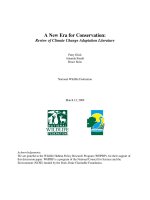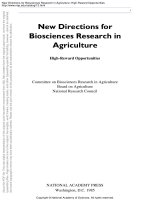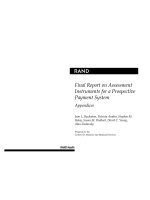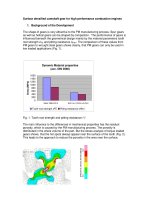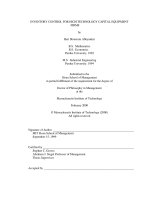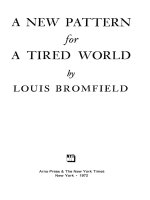Investigation on new material for high density recording media with high thermal stability
Bạn đang xem bản rút gọn của tài liệu. Xem và tải ngay bản đầy đủ của tài liệu tại đây (3.9 MB, 260 trang )
THEORETICAL AND EXPERIMENTAL STUDY
OF EXCHANGE COUPLED MEDIA
REN HANBIAO
NATIONAL UNIVERSITY OF SINGAPORE
2006
THEORETICAL AND EXPERIMENTAL STUDY
OF EXCHANGE COUPLED MEDIA
REN HANBIAO
(B. ENG. TSINGHUA UNIV.)
A THESIS SUBMITTED
FOR THE DEGREE OF PH. D OF PHILOSOPHY
DATA STORAGE INSTITUTE, A-STAR, SINGAPORE
ELECTRICAL AND COMPUTER ENGINEERING
DEPARTMENT
NATIONAL UNIVERSITY OF SINGAPORE
2006
i
ACKNOWLEDGEMENTS
I would like to express my sincere gratitude to my supervisors, A/Prof. Wang Jian Ping
and Prof Chong Tow Chong, for offering me the chance to study and do my research at
DSI, and for their invaluable advice and patient guidance throughout all my work done
there.
I am truly indebted to Dr. Shan Zhensheng, Dr. Zhou Tiejin, from whom I have gained
much theoretic knowledge and invaluable advice. Dr Shan also gave me helpful
support during VSM and AGM measurement.
I am especially thankful to Dr. Chen Jinshen, Lim Boon Chow, and Pock, who aided
me greatly in the trouble-shooting of the sputtering machine. They were always so
patient whenever I encountered any problem.
My thanks also go to:
Mr. Soo Eng Wei, Ms. Pang Siew It, Ms. Chow Shiaw Kee, Mr. Hee Ching Hian, and
all other staffs and fellow scholars of the Media and Materials Group from the Data
Storage Institute, Sun Chengjun, Jiang Weiwei, Shi Xiao, Zheng Yufang, Hu Jiangfeng,
Zhao Yan and Lü Meihua, who were extremely helpful with their assistance and
friendship. I particularly appreciate the opportunity to spend four years with my fellow
scholars.
I also would like to thank the National University of Singapore for its financial support
and the Data Storage Institute for supplying me with an excellent research environment.
Last, but not least, I am especially grateful to my wife Tan Qiuyan, my daughter, Ren
Jiayue and my family for their encouragement, care, and support.
ii
Contents
ACKNOWLEDGEMENTS i
Abstract ix
List of Figures and Illustrations xi
List of Tables xx
1 Introduction 1
1.1 Overview of magnetic recording industry 1
1.2 Brief overview of magnetic recording 3
1.3 Thin film media 5
1.3.1 Substrate 6
1.3.2 Underlayer and seedlayer 6
1.3.3 Intermediate layer 7
1.3.4 Magnetic layer 8
1.3.5 Overcoat and lubricant 9
1.4 Key performance indices for current medium 10
1.4.1 Areal density 11
1.4.2 Signal to noise ratio 12
1.4.3 Thermal stability factor 14
1.5 Issues with and resolutions for further increasing the areal density 16
1.5.1 Traditional medium structure 17
1.5.2 IBM and DSI proposed medium (AFC and LAC) 17
1.5.3 Fujitsu proposed medium (SFM) 18
1.5.4 Newly proposed medium in this work 18
1.6 Objective of this research 19
iii
1.7 Project scope 20
2 Literature review 24
2.1 The origin of exchange coupling 24
2.1.1 The concept of exchange interaction 24
2.1.2 Direct exchange interaction 25
2.1.3 Indirect exchange interaction 26
2.1.4 RKKY interaction 26
2.1.5 Superexchange interaction 27
2.1.6 Double exchange interaction 29
2.2 The interlayer exchange coupling and its effect on magnetic properties 30
2.2.1 Exchange anisotropy discovered by Meiklejohn and Bean 30
2.2.2 RKKY interlayer exchange coupling 35
2.3 The measurement of exchange coupling 35
2.3.1 Magnetization measurement 36
2.3.2 Torque measurements 37
2.3.3 Ferromagnetic resonance measurements 38
2.3.4 Neutron diffraction measurements 40
2.3.5 Magnetoresistance measurements 41
2.3.6 AC-susceptibility measurements 42
2.3.7 Domain observation measurements 43
2.3.8 Brillouin scattering measurements 43
2.3.9 Mössbauer effect measurements 44
2.4 Types of exchange coupled system 45
2.4.1 Small particles 45
2.4.2 Coated antiferromagnetic single crystals 46
iv
2.4.3 Thin films 46
2.4.4 Oxide thin film AFMs 47
2.4.5 Metallic thin film AFMs 48
2.4.6 Other thin film AFMs 48
2.4.7 Ferrimagnets 49
2.5 Factors that affect exchange coupling and the unidirectional anisotropy . 49
2.5.1 Thickness 49
2.5.2 AFM orientation 53
2.5.3 Interface roughness 54
2.5.4 Block temperature 55
2.5.5 Training effect 56
2.5.6 Perpendicular coupling 57
2.6 The theoretical research in exchange coupling 58
2.6.1 Néel domain model 60
2.6.2 Early random interface model 61
2.6.3 AF domain wall models 62
2.6.4 Orthogonal F and AF magnetic lattices 63
2.6.5 Random interface field models 64
2.6.6 The frozen interface model 66
2.6.7 Local pinning field variation 69
2.7 Perpendicular exchange coupled system 70
2.7.1 Perpendicular ferromagnetic layer thickness dependence 71
2.7.2 AFM layer thickness dependence 72
2.7.3 Interface between the FM and AFM layers. 75
2.7.4 Material of FM layers 76
v
2.7.5 Material of AFM layers 76
2.8 Summary 76
3 Experimental procedures 90
3.1 Introduction 90
3.2 Sputter deposition 91
3.2.1 Plasma generation and DC diode plasma generation 91
3.2.2 Condensation on the substrate to form the film on the surface 94
3.2.3 Magnetron DC diode plasma generation 95
3.2.4 DSI home designed UHV sputtering machine 96
3.3 Vibrating sample magnetometer (VSM) 97
3.4 Alternating gradient field magnetometer (AGFM) 99
3.5 Hysteresis loop 100
3.6 Thermal stability factor (SF) measurement 102
3.7 X-ray diffraction 103
3.8 Transmission electron microscopy (TEM) 105
4 Analytical model of S-W Particle 110
4.1 Introduction 110
4.2 Stoner-Wohlfarth Model: Uniform Rotation 111
4.3 The switching field h
k
113
4.4 Hysteresis loop 115
4.5 Energy barrier 118
4.6 Summary 121
5 Theoretical analysis on exchange coupled media 123
5.1 Introduction 123
5.2 Analytical model 123
vi
5.3 Results and discussion in the case where no external field is applied 125
5.3.1 Case I: No conditional local minimum energy state exists. 129
5.3.2 Case II: Conditional local minimum energy states exist 130
5.4 Results and discussion in the case with external field applied in the
direction of the easy axis. 135
5.4.1 Hysteresis loop: 135
5.4.2 Coercivity and switching field calculation and exchange bias 140
5.4.3 Energy barrier calculation 141
5.5 Results and discussion in the case with the field applied with an angle of
the easy axis 142
5.5.1 Hysteresis loop 142
5.5.2 Switching field 143
5.6 Special issue: estimation of J considering different easy axis directions 147
5.6.1 Analytical Model 148
5.6.2 Results and discussion 149
5.6.3
0=
θ
case 149
5.6.4 0≠
θ
case 153
5.7 Results and discussion in the case with strong exchange coupling 157
5.8 Summary 158
6 Effects of Dy-doping on magnetic and reversal properties of
recording media 161
6.1 Introduction 161
6.2 Experimental 161
6.3 Results and discussion 162
6.3.1 Effect of doping Dy into the Cr underlayer 162
vii
6.3.2 Effect of doping Dy into the Cr top-layer 164
6.4 Summary 166
7 Effects of perpendicular exchange coupling on the magnetic
properties of CoCrPtB-CoDy bilayers 168
7.1 Introduction 168
7.2 Literature review of amorphous rare earth-transition metal alloy 168
7.2.1 Magnetization for homogeneous A (RE) – B (TM) alloys [1,2] 169
7.2.2 The compensate point and magnetization curve change with the
temperature 172
7.2.3 Curie temperature change and its effect on composition 174
7.2.4 Perpendicular anisotropy dependence on the Co content of CoDy
amorphous film 174
7.3 Experimental 175
7.4 Exchange coupling effect of a CoDy toplayer to a perpendicular CoCrPtB
magnetic layer 178
7.5 The exchange bias field (H
ex
) and interface domain wall energy (σ)
dependence on the magnetic properties (H
c
) of the CoDy layer 187
7.6 Magnetic behaviors of exchange coupled CoDy/CoCrPtB bilayers
dependence on the Co content of CoDy layer 188
7.7 Magnetic behaviors of exchange-coupled CoDy/CoCrPtB bilayers’
dependence on the thickness of a CoDy layer 209
7.8 Interface domain wall energy estimation by the different magnetization
reversals 224
7.9 Training effect of the magnetization and exchange bias for the
CoDy/CoCrPtB coupled bilayers 227
viii
7.10 Summary 231
8 Conclusion 235
ix
Abstract
Thermal instability due to the superparamagnetism is one of key concerns for future
magnetic recording media. Indirect exchange coupling through an interlayer has been
successfully used in recently proposed and commercialized antiferromagnetically
coupled medium (AFC) to solve the thermal stability issue for longitudinal recording
media. This study proposed and investigated for the first time a novel exchange-
coupled bilayers structure that used an antiferromagnetic layer to directly exchange-
couple with a magnetic layer (recording layer), which was not only meaningful for
longitudinal media but also important for future perpendicular media and/or heat
assisted magnetic recording media. A theoretical model for the proposed exchange-
coupled bilayers structure was built up for the first time. Magnetization switching
behaviors of such medium structure were calculated based on this model. The
theoretical calculation was well consistent with the experimental results. To implement
this new medium structure, an antiferromagnetic CoDy layer was chosen and sputtered
on top of a CoCrPtB magnetic layer with perpendicular anisotropy. The exchange
coupling in such medium structure was shown to be much higher than that in the AFC
medium. The composition and thickness effects of CoDy layer in such medium
structure were investigated systematically. The exchange coupling effect between
CoDy layer and CoCrPtB layer was made clear by analyzing the shape of major and
minor hysteresis loops, DC demagnetizing remanence curves (DCD curves), and
switching field distribution curves. It was found that the magnetic properties of the
CoCrPtB layer were changed greatly through the exchange coupling with the CoDy
layer. The improvement of coercivity (H
c
) and thermal stability factor (SF) was mainly
due to the exchange coupling between the two layers and was much dependent on the
Co content in CoDy layer and the thickness of the CoDy layer. The exchange bias
x
training effect was studied, and for the first time the magnetization training effect was
found for the exchange-coupled bilayers system, which was a new fundamental finding
on the exchange-coupled bilayers structure. In summary this study has for the first time
proposed, implemented experimentally and demonstrated successfully a new magnetic
bilayers structure consisted of an antiferromagnetic layer (CoDy in this study) and a
ferromagnetic layer (perpendicular CoCrPtB in this study) through a direct exchange
coupling. This novel structure showed an improved thermal stability and will be one of
candidates for future extremely high areal density recording media.
xi
List of Figures and Illustrations
Figure 1.1 The rate of evolution of rigid disk technology represented as a graph of
areal density versus production year [4].
Figure 1.2 Comparison of HDD and DRAM recording areal density improvement
over the years [4].
Figure 1.3 Schematic diagrams showing the basic principle of the magnetic
recording system: (a) Longitudinal magnetic recording, (b)
Perpendicular recording using a probe head and a soft underlayer in the
medium, and (c) Perpendicular recording using a ring head and no soft
underlayer [5].
Figure 1.4 Structure of typical thin film medium of current longitudinal medium.
Figure 1.5 Schematic representation of the evolution of actual bit size in terms of
areal density. The bit width is given in kilobits per square inch (kbpi),
and the bit length is given in terms of tracks per inch (tpi).
Figure 1.6 Structure of magnetic layer of IBM and DSI proposed medium.
Figure 1.7 Structure of magnetic layer of Fujitsu designed medium.
Figure 1.8 Structure of magnetic layer of the designed medium in this work.
Figure 2.1 Function form of RKKY interaction
Figure 2.2 Crystal and magnetic structure of MnO
Figure 2.3 The p-orbit of the O
2-
ion through which exchange interaction acts
between the spins on magnetic ions M
1
and M
2
.
Figure 2.4 (a) Hysteresis loops at 77 K of partially oxidized Co particles. Curve (1)
shows the resulting loop after cooling the compact in a 10 kOe field.
Curve (2) shows the loop when cooled in zero field. (b) Torque curves
on partially oxidized Co particles cooled in a field to 77 K, where h is
the angle between the cooling field axis and the direction of the
measuring field. Curves a and b in (b) are for counterclockwise and
clockwise rotations, respectively. Refs. [1,2].
Figure 2.5 Schematic of an ideal FM/AFM interface. The FM and AFM layers are
single crystal and epitaxial with an atomically smooth interface. The
interfacial AFM spin plane is fully uncompensated. For this ideal
interface, the calculated value of the full interfacial energy density is
about two orders of magnitude larger than the experimentally observed
values.
xii
Figure 2.6 Interfacial complexities of a polycrystalline FM(metal) /AFM(oxide)
interface. The interfacial spins prefer to align ferromagnetically in this
figure. The X marks identify the frustrated exchange bonds (i.e., the
interfacial spins that are coupled antiferromagnetically). The interfacial
region can have a high degree of stress since metals and oxides often
have different lattice parameters. Dislocations (represented by the
dashed line) can form during film growth to relieve the stress.
Figure 2.7 Hysteresis loop for NiFe/NiO with G =15 Oe/mm using AGFM.
Figure 2.8 (a) Torque magnetization, Γ, and (b) rotational hysteresis, W
R,
for an
oxidized Co film at T = 77 K after field cooling [64].
Figure 2.9 Perpendicular FMR spectrum of trilayer Si (100) / WTi (6.7 nm) / NiFe
(30.5 nm) / FeMn (13.6 nm) / NiFe (10.1 nm)/WTi(6.7 nm),. The
absorption fields and line widths values are, respectively, 13130 and 47
Oe for the main uniform mode a and 12 709 and 79 Oe for the second
mode b [65]
Figure 2.10 Parallel FMR spectra of trilayer Si (100) / WTi (6.7 nm) / NiFe (30.5
nm) / FeMn (13.6 nm) / NiFe(10.1 nm)/WTi(6.7 nm), In-plane applied
static field (a) parallel, (b) perpendicular, and (c) antiparallel to the
direction of the exchange bias field.
Figure 2.11 Neutron diffraction patterns of CoAl
0.1
Fe
1.9
O
4
at various temperatures
[71]
Figure 2.12 (a) Schematic diagram of a spin valve device. (b) Hysteresis loop, m(H),
and (c) magnetoresistance, ∆R/R(H), of Fe
20
Ni
80
/Cu/Fe
20
Ni
80
/FeMn
GMR spin valve at room temperature[80].
Figure 2.13 Mössbauer spectra of CoAl
0.2
Fe
1.8
O
4
at various temperatures.[71]
Figure 2.14 The dependence of exchange bias and coercivity on the thickness of
Ni
80
Fe
20
for a Ni
80
Fe
20
/Fe
50
Mn
50
bilayer. [126]
Figure 2.15 Dependence of exchange bias H
E
(square symbols) and coercivity H
c
(triangular symbols) with the AFM layer thickness for Fe
80
Ni
20
/FeMn at
a fixed t
FM
= 7 nm [42]. Note that 80 A/m =1 Oe.
Figure 2.16 The values of exchange field H
E
measured at 80K and 250 K for 300 Å
NiFe/x Å CoO/300 Å Cu as a function of the CoO layer thickness. The
dashed line for the data at 80 K is 1/t
AF
.
Figure 2.17 Schematic spin diagram for a (a) compensated and (b) uncompensated
AFM surface.
Figure 2.18 Schematic diagrams of spin–spin coupling states at the interface of: (a)
FI/FI and (b) AFM/FM bilayers. [128]
xiii
Figure 2.19 Roughness dependence on ∆σ of the bilayers of Tb
26.1
(Fe
80
Co
20
)
73.9
(20
nm)/Tb
16.2
(Fe
80
Co
20
)
83.7
(20 nm) and IrMn ( 9nm)/ NiFe (20 nm).
Notice that the wavelength of the roughness also varies from 18 to 39
nm with increasing rms roughness.[128]
Figure 2.20 Blocking temperature T
B
(solid squares) of 300 Å NiFe/x Å CoO/ 300
Å Cu and Néel temperature T
N
(open circle) of CoO/SiO
2
multilayers,
as a function of the CoO layer thickness. [129]
Figure 2.21 (a) Representative hysteresis loops of training effect of mixed Fe
x
O and
α-Fe
2
O
3
(50 nm)/NiFe (5 nm) film. M–H loop cycles 1, 2, 4, 8, 12, 20
are shown. (b)
+
sw
H , H
c
,H
eb
,
−
sw
H plotted as a function of the number
of the loop cycles. (c) Representative hysteresis loops of training effect
of mixed FexO and Fe
x
O and α-Fe
2
O
3
(70 nm)/CoFe (5 nm) film. M–H
loop cycles 1, 2, 4, 8, 12, 20 are shown. (d)
+
sw
H , H
c
,H
eb
,
−
sw
H plotted
as a function of the number of the loop cycles. [130]
Figure 2.22 Schematic diagram of angles involved in an exchange bias system. Note
that the AFM and FM anisotropy axes are assumed collinear and that
the AFM sublattice magnetization M
AFM
has two opposite directions.
Figure 2.23 AF rough interface with frustrated interactions marked by full dots. The
dashed line marks the boundary between the F and the AF layer.
Figure 2.24 Illustration of the perpendicular F and AF magnetic interface
configuration, with spin canting in the first AF layer.
Figure 2.25 Exchange bias field (H
eb
) and coercivity (H
c
) vs top Co thickness
Figure 2.26 Exchange bias field (Heb) and coercivity (Hc) vs the number of bilayers.
Figure 2.27 (a) Dependence of the exchange bias field on the IrMn layer thickness
for [Pt(2 nm)/Co(0.5 nm)]3 / IrMn (t nm) /Pt (2 nm) multilayers on
arrays with different particle sizes and flat SiO2 substrates. (b)
Exchange bias field as a function of the inverse IrMn layer thickness for
films on plain SiO2 substrates. The solid line is a linear fit to the data.
[165]
Figure 2.28 Dependence of the exchange bias field on the inverse particle diameter
for [Pt (2 nm)/ Co (5 nm)]
3
/ IrMn (t nm) / Pt (2 nm) caps with different
IrMn layer thickness t. The solid line is a linear fit to the data for t ≥10
nm. [165]
Figure 3.1 Schematic diagram of a DC-sputtering system.
Figure 3.2 (a) Structure of the glow discharge of a DC diode system (b) The charge
particle concentration of a glow discharge (c) The voltage variation of
the glow discharge.
xiv
Figure 3.3 The phenomenon occurring when the incident ions strike the target
surface: atoms ejected.
Figure 3.4 The species arriving at and interacting with the substrate in a sputtering
system.
Figure 3.5 Cross section of circular magnetron sputter source, with permanent bar
magnets behind the target, and depicting magnetic field, race track, and
electron orbits.
Figure 3.6 Schematic drawing of a multi-function UHV sputtering system (DSI
home-designed).
Figure 3.7 Schematic diagram of a Vibrating Sample Magnetometer (VSM) with
computer control.
Figure 3.8 (a) Overall system of an Alternate Gradient Field Magnetometer
(AGFM) configuration. (b) The structure of bimorph, extension and
sample.
Figure 3.9 Princeton MicroMag
TM
AGFM system.
Figure 3.10 Typical hysteresis loop and parameters measured by VSM.
Figure 3.11 Time-dependence measurement for obtaining thermal stability factor,
K
u
V*/k
B
T.
Figure 3.12 The lattice plane formed in the atoms and the basics of Bragg's law.
Figure 3.13 The XRD data of series films glass/Ti/CoCrPtB/Ti deposited at
different temperatures with Ti (002) peak and Co (002) peak.
Figure 3.14 The schematic diagram of a transmission electron microscope (TEM).
Figure 4.1 Diagram of a single-domain particle with uniaxial anisotropy
K and
applied field H.
Figure 4.2 Normalized energy vs. the magnetization direction
α
with different
applied field. The external field applied along the easy axis.
Figure 4.3 The normalized switching field
h
k
dependence on the external applied
field direction angle
θ.
Figure 4.4 The hysteresis loop of S-W particle with the different applied field
angle
θ.
Figure 4.5 Normalized coercivity of S-W model particle dependence on the
external applied field direction angle
θ.
Figure 4.6 Normalized energy barrier e vs. the external applied field h. The
external field is applied along the direction of the easy axis.
xv
Figure 4.7 The normalized energy barrier e
b
dependence on the normalized
external applied field h.
θ
is the angle between the direction of external
applied field and that of the easy axis.
Figure 5.1 (a) Schematic of antiferromagnetically coupled medium (AFC); (b)
Configuration of magnetization M
1
, M
2,
and applied H-field with
respect to the energy easy axis.
Figure 5.2 Hysteresis loop for the case with high exchange coupling constant J.
The external field applied along the easy axis.
Figure 5.3 Energy change with the magnetization angle
α
and
β
in case I. No
external field was applied on the AFC system.
Figure 5.4 Hysteresis loop for the case with lower exchange coupling constant
J.
The external field is applied along the easy axis.
Figure 5.5 Energy change with the magnetization angle
α
and
β
in case II. No
external field was applied on the system.
Figure 5.6 Energy barriers (P3->P1, P3->P2) of an antiferromagnetically coupled
medium with initial parallel configuration.
Figure 5.7 Energy barriers of bottom layer switching (P3->P1) relation with the
exchange bias j.
Figure 5.8 Hysteresis loop of the antiferromagnetically coupled system. The
external field applied along the easy axis, f
k
= f
m
=0.2, j = 0.01.
Figure 5.9 Hysteresis loop of the antiferromagnetically coupled system. The
external field applied along the easy axis, f
k
= f
m
=0.2, j = 0.1.
Figure 5.10 Hysteresis loop of the antiferromagnetically coupled system. The
external field applied along the easy axis, f
k
= f
m
=0.2, j = 0.4.
Figure 5.11 Normalized energy barriers changes with the external applied field h.
The external field is applied on the easy axis.
Figure 5.12 A typical hysteresis loop for a magnetically exchange coupled system.
In this calculation, K
1
= K
2
= 1×10
6
erg/cm
3
, M
1
= M
2
= 350 emu/cm
3
, t
1
= 15 nm, t
2
= 5 nm.
Figure 5.13 Calculated hysteresis loop for magnetically exchange coupled system
with low exchange coupling constant. Solid line is the major loop for
M
1
layer. Dot line is the minor loop for M
2
layer.
Figure 5.14 Top-layer (M
1
) switching field (h
1n
) dependence on the external applied
field angle θ, h
n
is switching field of single layer, h
1n
-h
n
is the increment
of switching field due to the effect of antiferromagnetic coupling.
Figure5.15 The dependence of the increment of switching field (h
1n
-h
n
) of top layer
(M
1
) on the antiferromagnetic coupling constant J.
xvi
Figure 5.16 Bottom layer (M
2
) switching field (h
2n
) dependence on the external
applied field angle θ, h
n
is switching field of single layer, h
2n
-h
n
is the
increment of switching field due to the effect of antiferromagnetic
coupling.
Figure 5.17 The dependence of the increment of switching field (h
2n
-h
n
) of bottom
layer (M
2
) on the antiferromagnetic coupling constant J.
Figure 5.18 Normalized h
ex
dependence on the normalized exchange coupling
constant j. (a) in the case that f
m
=0.3; (b)in the case that f
m
=0. 6.
Figure 5.19 Normalized exchange bias h
ex
dependence on the external applied field
angle. (f
k
=1/3. f
m
=1/3). (a) in the case that j =0.033; (b) in the case that j
=0.167.
Figure 5.20 a dependence on the orientation ratio (OR) of M
r
. f
k
=1/3. f
m
=1/3.
Figure 6.1 Dependence of H
c
, SF on the Dy content in CrDy underlayer.
Figure 6.2 XRD diffraction spectra of the films with different Dy content in CrDy
underlayer.
Figure 6.3 Dependence of Hc, SF on the Dy content in CrDy toplayer.
Figure 6.4 XRD diffraction spectra of the films with different Dy content of CrDy
toplayer.
Figure 6.5 Hysteresis loop for the medium with CrDy toplayer (10% Dy).
Figure 7.1 The Co concentration dependence of magnetization for Co-Dy alloys,
the total magnetization
σ
, Dy-subnetwork magnetization
Dy
σ
, and Co-
subnetwork magnetization
Co
σ
.
Figure 7.2 Temperature dependence of the saturation magnetization for amorphous
Dy-Co alloys. The dashed lines were calculated from the mean-field
theory.
Figure 7.3 Thermal-magnetic curves of Co
51
Dy
49
with different thickness in an
applied field of 100 Oe [4].
Figure 7.4 Compositional variation of the compensation temperature for
amorphous RE-TM alloys with RE = Gd, Tb, Dy, Ho for TM = Co.
Figure 7.5 Compositional variation of the Curie temperature for amorphous RE-Co
alloys with RE = Gd, Tb, Dy, Ho, Here Dy-Co (circles).
Figure 7.6 The anisotropy of CoDy film dependence on Co content of CoDy.
Figure 7.7 The magnetic properties of samples deposited with different
temperatures.
xvii
Figure 7.8 H
c
and thermal stability factor (SF) dependence on the Co content of
CoDy layer.
Figure 7.9 H
c
and thermal stability factor (SF) dependence on the Co content of
CoDy layer.
Figure 7.10 Switching field (H
s
) dependence on the Co content of CoDy layer.
Figure 7.11 The saturated magnetization dependence on the Co content of CoDy
layers.
Figure 7.12 XRD spectrum of film: glass /Ti (40 nm) /CoCrPtB (35 nm)
/Co
79.8
Dy
20.2
(20 nm) / Ti (4 nm).
Figure 7.13 TEM image of sample: glass /Ti (40 nm) /CoCrPtB (35 nm)
/Co
79.8
Dy
20.2
(20 nm) / Ti (4 nm).
Figure 7.14 TEM image of sample: glass /Ti (40 nm) /CoCrPtB (35 nm)
/Co
77.8
Dy
22.2
(20 nm) / Ti (4 nm).
Figure 7.15 The exchange coupling strength (erg/cm
2
) dependence on the Co
content of CoDy layers.
Figure 7.16 The magnetization and coercivity of minor loop dependence on the Co
content of CoDy layers.
Figure 7.17 The exchange bias H
ex
and the exchange coupling energy dependence
on the coercivity of CoDy layer with different Co content.
Figure 7.18 Hysteresis loop of the sample with the structure of glass / Ti (40 nm) /
CoCrPtB (35 nm) / Ti (4 nm).
Figure 7.19 Hysteresis loop of the sample with the structure of glass / Ti (40 nm) /
CoCrPtB (35 nm) /Co
81
Dy
19
(20 nm) / Ti (4 nm) toplayer.
Figure 7.20 Hysteresis loop of the sample with the structure of glass / Ti (40 nm) /
CoCrPtB (35 nm) / Co
79
Dy
21
(20 nm) / Ti (4 nm) toplayer.
Figure 7.21 Hysteresis loop of the sample with the structure of glass / Ti (40 nm) /
CoCrPtB (35 nm) / Co
77
Dy
23
(20 nm) / Ti (4 nm) toplayer.
Figure 7.22 Multi-minor hysteresis loops of the sample with the structure of glass /
Ti (40 nm) / CoCrPtB (35 nm) / Ti (4 nm).
Figure 7.23 Multi-minor hysteresis loops of the sample with the structure of glass /
Ti (40 nm) / CoCrPtB (35 nm) / Co
81
Dy
19
(20 nm) / Ti (4 nm).
Figure 7.24 Multi-minor hysteresis loops of the sample with the structure of glass /
Ti (40 nm) / CoCrPtB (35 nm) / Co
79
Dy
21
(20 nm) / Ti (4 nm).
Figure 7.25 Multi-minor hysteresis loops of the sample with the structure of glass /
Ti (40 nm) / CoCrPtB (35 nm) / Co
77
Dy
23
(20 nm) / Ti (4 nm).
xviii
Figure 7.26 The DCD curve of the sample with the structure of glass / Ti (40 nm) /
CoCrPtB (35 nm) / Ti (4 nm).
Figure 7.27 The switching field distribution of the sample with the structure of glass
/ Ti (40 nm) / CoCrPtB (35 nm) / Ti (4 nm).
Figure 7.28 The DCD curve of the sample with the structure of glass / Ti (40 nm) /
CoCrPtB (35 nm) / Co
81
Dy
19
(20 nm) / Ti (4 nm).
Figure 7.29 The switching field distribution of the sample with the structure of glass
/ Ti (40 nm) / CoCrPtB (35 nm) / Co
81
Dy
19
(20 nm) / Ti (4 nm).
Figure 7.30 The DCD curve of the sample with the structure of glass / Ti (40 nm) /
CoCrPtB (35 nm) / Co
79
Dy
21
(20 nm) / Ti (4 nm).
Figure 7.31 The DCD curve of the sample with the structure of glass / Ti (40 nm) /
CoCrPtB (35 nm) / Co
77
Dy
23
(20 nm) / Ti (4 nm).
Figure 7.32 The switching field distribution of the sample with the structure of glass
/Ti (40 nm) / CoCrPtB (35 nm) Co
79
Dy
21
(20 nm) / Ti (4 nm).
Figure 7.33 The switching field distribution of the sample with the structure of glass
/ Ti (40 nm) / CoCrPtB (35 nm) / Co
77
Dy
23
(20 nm) / Ti (4 nm).
Figure 7.34 The hysteresis loop of the sample with the structure of glass / Ti (40 nm)
/ CoCrPtB (35 nm) / Ti (4 nm).
Figure 7.35 The hysteresis loop of the sample with the structure of the glass / Ti (40
nm) / CoCrPtB (35 nm) / CoDy (5 nm) / Ti (4 nm).
Figure 7.36 The hysteresis loop of the sample with the structure of glass / Ti (40 nm)
/ CoCrPtB (35 nm) / CoDy (10 nm) / Ti (4 nm).
Figure 7.37 The hysteresis loop of the sample with the structure of glass / Ti (40 nm)
/ CoCrPtB (35 nm) / CoDy (15 nm) / Ti (4 nm).
Figure 7.38 The hysteresis loop of the sample with the structure of glass / Ti (40 nm)
/ CoCrPtB (35 nm) / CoDy (20 nm) / Ti (4 nm).
Figure 7.39 The hysteresis loop of the sample with the structure of glass / Ti (40 nm)
/ CoCrPtB (35 nm) / CoDy (30 nm) / Ti (4 nm).
Figure 7.40 The DCD curve of the sample with the structure of glass / Ti (40 nm) /
CoCrPtB (35 nm) / Ti (4 nm).
Figure 7.41 The DCD curve of the sample with the structure of glass / Ti (40 nm) /
CoCrPtB (35 nm) / CoDy (5 nm) / Ti (4 nm).
Figure 7.42 The switching field distribution of the sample with the structure of glass
/ Ti (40 nm) / CoCrPtB (35 nm) / Ti (4 nm).
xix
Figure 7.43 The switching field distribution of the sample with the structure of glass
/ Ti (40 nm) / CoCrPtB (35 nm) / CoDy (5 nm) / Ti (4 nm).
Figure 7.44 The DCD curve of the sample with the structure of glass / Ti (40 nm) /
CoCrPtB (35 nm) / CoDy (10 nm) / Ti (4 nm).
Figure 7.45 The switching field distribution of the sample with the structure of glass
/ Ti (40 nm) / CoCrPtB (35 nm) / CoDy (10 nm) / Ti (4 nm).
Figure 7.46 The DCD curve of the sample with the structure of glass / Ti (40 nm) /
CoCrPtB (35 nm) / CoDy (15 nm) / Ti (4 nm).
Figure 7.47 The DCD curve of the sample with the structure of glass / Ti (40 nm) /
CoCrPtB (35 nm) / CoDy (20 nm) / Ti (4 nm).
Figure 7.48 The switching field distribution of the sample with the structure of glass
/ Ti (40 nm) / CoCrPtB (35 nm) / CoDy (15 nm) / Ti (4 nm).
Figure 7.49 The switching field distribution of the sample with the structure of glass
/ Ti (40 nm) / CoCrPtB (35 nm) / CoDy (20 nm) / Ti (4 nm).
Figure 7.50 The DCD curve of the samples with the structure of glass / Ti (40 nm) /
CoCrPtB (35 nm) / CoDy (30 nm) / Ti (4 nm).
Figure 7.51 Multi-minor hysteresis loops of the sample with the structure of glass /
Ti (40 nm) / CoCrPtB (35 nm) / CoDy (30 nm) / Ti (4 nm).
Figure 7.52 The switching field distribution of the sample with the structure of glass
/ Ti (40 nm) / CoCrPtB (35 nm) / CoDy (30 nm) / Ti (4 nm).
Figure 7.53 The exchange coupling strength J estimated by the minor loop.
Figure 7.54 The exchange coupling strength estimation by the DCD curve.
Figure 7.55 The hysteresis loop dependence on the field cycle number for sample
310. The number of hysteresis loop goes from 1 to 50.
Figure 7.56 The training effect of the coercivity of CoDy layer of minor hysteresis
loop for sample 310.
Figure 7.57 The training effect of the exchange bias field of CoDy layer of minor
hysteresis loop for sample 310.
Figure 7.58 The training effect of H
c
of the hysteresis loop of CoDy layer: the left
and right switching field of CoDy layer of minor hysteresis loop for
sample 310.
Figure 7.59 The training effect of the magnetization of the sample 310.
xx
List of Tables
Table 2.1 Summary of exchange bias and related properties for different small
particle systems. Note that the given loop shifts, H
E
, are at T = 4–10 K.
Table 5.1 The magnetic parameters (h
11
, h
12
, h
21
) of exchange coupled system with
different exchange coupling constant j, the f
k
and f
m
are chosen as 0.2.
Table 5.2 The comparison of energy barrier between experimental and analytical
work. The magnetic parameters for this table are, f
k
= 0.5, h
ex
= 0.036, f
m
=
0.5.
Table 7.1 The experimental condition and structure for sputtering CoCrPtB layers. t
is the sputtering temperature of substrate and is set to 200 ◦C, 250 ◦C and
300 ◦C.
Table 7.2 The magnetic properties of samples for optimizing the CoCrPtB layer
sputtering temperature.
Table 7.3 The film structure for samples to study the CoDy coupling effect with
different Co content of CoDy layer.
Table 7.4 Magnetic properties of samples with different Co content of CoDy layer.
Table 7.5 Magnetic properties of samples with different Co content of CoDy layer.
Table 7.6 The exchange bias H
ex
and interface wall energy σ dependent on the
coercivity of CoDy layer with different Co content. tMH
CoDyex
2=
σ
.
Chapter 1 Introduction
1
1 Introduction
1.1 Overview of magnetic recording industry
As the field of information technology rapidly advances, the need for larger storing
capacity accordingly increases. Among data storage methods, magnetic storage is the
most economical one. The hard disk drive provides nearly half of all computer storage.
This includes the traditional desktop computer, which usually uses a 95 mm disk-drive
containing one or more disks, where the substrate generally used is AlMg alloy and
glass coated with a number of underlayers and seedlayers to produce the required
magnetic properties on the resulting disk. Lap-top computers usually contain a much
smaller disk-drive (65 mm or 45mm), where the substrate material is usually glass or
glass ceramic. High-end servers for electronic mail applications require large capacity,
high data-rate disk-drives to cope with the increasing amount of information
exchanged via this medium.
Since the first magnetic disk drive (RAMAC 350), which had an areal density of 2
Kbits/in
2
,
was invented at IBM in 1955, the technology of magnetic recording has
advanced very rapidly. The areal density for information storage on magnetic media,
especially hard disks, has been increasing at an astonishing rate over the last three
decades. The oft-quoted density growth rates are 30% per year for 1970-1990 and 60%
per year since 1990
[1]. Significant improvement came in 1992 with the introduction
of smoother sputter-deposited thin film media to replace the binder-based particulate
media, the magneto resistive (MR) head and giant magneto resistive (GMR) head
playback transducers. After demonstration at 20 Gbits/in
2
in 1999, the areal densities
achieved in products have grown at a rate approaching 100% per year due to the
Chapter 1 Introduction
2
introduction of giant magnetoresistive (GMR) spin-valve heads by IBM in 1998
[2].
The evolution of hard disk storage in terms of areal density is even faster than that of
semiconductor DRAM memory. Areal densities of over 100 Gbits/in
2
have now been
demonstrated
[3]. Figure 1.1 shows areal density improvement of hard disk over the
years, while Figure 1.2 compares the storage capacities of hard disk and DRAM
memory. The areal density improvement of hard disks is greater than that of the
DRAM. The principle of information storage in hard disk is magnetic recording. My
study focuses on the magnetic materials used for magnetic recording. Brief magnetic
recording and disk structure are explained in the subsequent paragraphs.
Figure 1.1 The rate of evolution of rigid disk technology represented as a graph of
areal density versus production year
[4].
Chapter 1 Introduction
3
Figure 1.2 Comparison of HDD and DRAM recording areal density improvement over
the years
[4].
1.2 Brief overview of magnetic recording
Magnetic recording is a process in which data is stored in a magnetic medium by a
magnetic recording head (write head). The recording medium consists of a substrate
coated with a magnetic layer that can be permanently magnetized, thus permitting
information to be stored magnetically. The write head is fed with a current containing
the information to be recorded. Upon moving the write head at a constant speed
relative to the medium, the fringing fields from the head gap permanently magnetize
the magnetic layer of the medium, and the information is stored. At replay, the medium
is again moved past a read head (which can be the same as the writing head or can be a
different part), and the flux emanating from the medium and entering the read head
gives rise to a read-back signal. Today, the magnetic states on the medium are sensed
